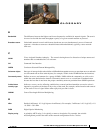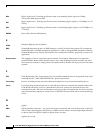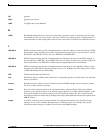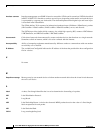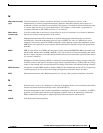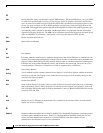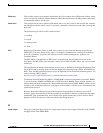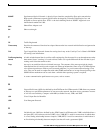
Glossary
GL-9
Cisco ASR 1000 Series Aggregation Services Routers MIB Specifications Guide
OL-15161-06
SONET
Synchronous Optical Network. A physical layer interface standard for fiber optic transmission.
High-speed synchronous network specification developed by Telcordia Technologies, Inc. and
designed to run on optical fiber. STS-1 is the basic building block of SONET. Approved as an
international standard in 1988.
SPA
Shared Port Adapter card
SX
Short wavelength
T
TE
Traffic Engineered
Time stamp
Provides the amount of time that has elapsed between the last network reinitialization and generation
of the trap.
TLV
Type Length Value. Dynamic format for storing data in any order. Used by Cisco’s Generic ID PROM
for storing asset information.
Traffic engineering
tunnel
A label-switched tunnel that is used for traffic engineering. Such a tunnel is set up through means other
than normal Layer 3 routing; it is used to direct traffic over a path different from the one that Layer 3
routing could cause the tunnel to take.
Trap
An trap is an unsolicited (device initiated) message. The contents of the message might be simply
informational, but it is mostly used to report real-time trap information. Since a trap is a UDP datagram,
sole reliance upon them to inform you of network problems (i.e. passive network monitoring) is not
wise. They can be used in conjunction with other SNMP mechanisms as in trap-directed polling or the
SNMP inform mechanism can be used when a reliable fault reporting system is required.
Tunnel
A secure communication path between two peers, such as routers.
U
UBR
Unspecified bit rate. QOS class defined by the ATM Forum for ATM networks. UBR allows any amount
of data up to a specified maximum to be sent across the network, but there are no guarantees in terms
of cell loss rate and delay. Compare with ABR (available bit rate), CBR, and VBR.
UDI
Cisco Unique Device Identifier
UDP
User Datagram Protocol.
V
VBR
Variable bit rate. QOS class defined by the ATM Forum for ATM networks. VBR is subdivided into a
real time (RT) class and non-real time (NRT) class. VBR (RT) is used for connections in which there
is a fixed timing relationship between samples. VBR (NRT) is used for connections in which there is
no fixed timing relationship between samples, but that still need a guaranteed QOS.



